The fall foliage in the Takase Gorge are known as one of the prefectures leading scenic spots. Mt. Yarigatake (3,180 m) is the source of the Minamata River that flows into the Takase River. The river then flows through 3 dams, furthest upstream is the Takase Dam, followed by the Nanakura Dam and Omachi Dam.
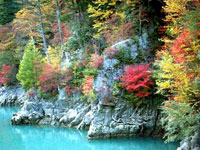
Fall Foliage in Takase Gorge
The Takase Gorge is one of the premiere autumn leaf viewing spots in Nagano prefecture.
In particular the views from Takesawa Dam, the Kitakuzusawa River, and the Oirizawa Bridge are spectacular. The best viewing time is mid-October to early November.

Takase Dam
Being the second highest dam in Japan, behind Kurobe dam, with the crest height of 176 m, Takase dam is the foremost rock-fill dam in the country. The dam was built using rock and gravel excavated from the area now flooded by the lake.
This is also a starting point for mountain trails to Mt. Yumatadake and Mt. Eboshidake. There is a popular 1-hour hiking course to Nigorisawa Falls that passes through a tunnel and over a suspension bridge.
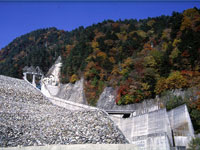
Nanakura Dam
Nanakura dam is a rock-fill dam built from natural stonework. It is 125-m high. The spring scenery and fall foliage are brilliant. The combination of the orange leaves and cobalt blue lake is particularly spectacular. Nanakura is also a starting point for hikers climbing Mt. Funakubodake and Mt. Kitakuzudake.
This is the furthest point accessible to private cars. There is a special taxi service available between Nanakura Dam and Takase Dam.
See more about Special taxi
.
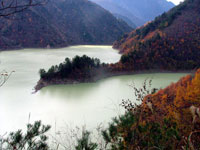
Omachi Dam (Lake Ryujin)
Omachi Dam is a multipurpose dam that was built in the wake of terrible flooding that occurred in August 1969. The dam’s lake was named “Lake Ryujin (Dragon God Lake)” after the local folklore of the region. The surrounding area is a natural treasure-trove. Between May and October is the best time to see a variety of wildflowers and animals. A stroll between late October and early November is also recommended, as you can enjoy the fall foliage.
Official website (Japanese)
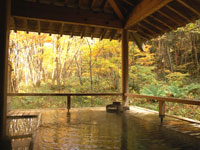
Kuzu Hot Springs
Kuzu Hot Springs are said to have a 300-year history. With an abundant supply of hot water, the open air baths of the three inns located here offer wonderful views of the spring greens, autumn leaves, and winter snows. You can also savor the local flavors of edible wild plants and white-spotted char (river fish).
There is more information on Kuzu Hot Springs here.
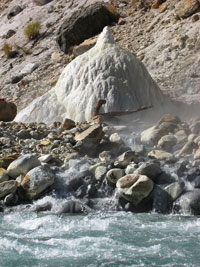
Yumata Hot Springs and Funtokyu (Hot Springs Mineral Deposit Mounds)
Yumata Hot Springs (Seiranso) is located about 2 and a half hours walk from the Takase Dam, in the depths of the Takase Gorge. It has a rich supply of hot water to its indoor and outdoor baths. The large numbers of fish in the mountain stream have also made this rustic hot spring popular with anglers. It is a famous climbing base for the Uraginza route traversing the Japan Alps and leading to Mt. Yari. As such, the hot springs are much loved by climbing and hiking enthusiasts.
Open from July to October.
It is also possible to see Funtokyu, natural formations caused by mineral deposits from hot spring water in the nearby river bed, designated as a national natural monument.

